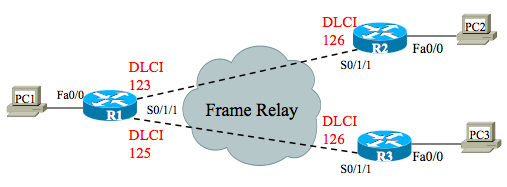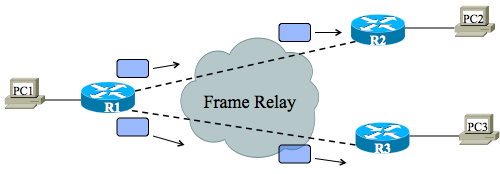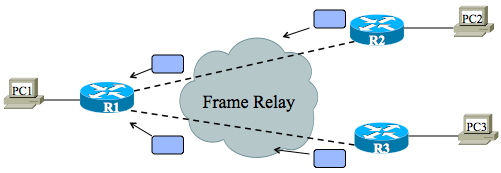FR DLCI Drill #2
Feel the need to work through how Frame Relay DLCIs work? This is a way to apply those ideas and prove you know how DLCIs really work. Now that I’ve posted the first drill of this type, I’ll keep the instructions on this one short. Short version: I’ll give some a little FR documentation, and you tell me other facts about the FR network: global DLCIs, local DLCIs, and what DLCIs sit in the FR headers as the frames pass through the FR network. Check out the first one in the series for a little more background.
All the drill start with a figure, in this case figure 1. It uses either local or global DLCI conventions, and it is accurate. In other words, I’m not trying to trick you by giving you wrong info.
Figure 1 – Initial Documentation, FR Drill 2

Your job: decide if Figure 1 shows local or global DLCIs. Then draw a new figure, showing the other style of DLCIs (if possible). Then show the DLCIs that will be in the headers of the Frame Relay frames shown in Figures 3 and 4. That’s it! The following list summarizes the steps, and numbers them for easier reference when I show the answers. Also, if you feel like you want more info about what to do, check out that first FR DLCI drill.
- Does the supplied figure show local DLCIs, global DLCIs, or is it impossible to tell?
- Create a new figure. If Figure 1 listed local DLCIs, list global DLCIs on the new figure, or vice versa.1
- Think about Frame Relay frames going left to right in Figure 3. List the DLCI(s) that will exist in each FR header, going into the FR network and exiting the FR network.
- Think about Frame Relay frames going right to left in Figure 4. List the DLCI(s) that will exist in each FR header, going into the FR network and exiting the FR network.
1Note that if Figure 1 lists local DLCIs, it may not be possible to list global DLCIs, depending on whether the example uses DLCIs that support the global DLCI assignment strategy.
Figure 3 – Predict DLCIs in the Header: Left to Right

Figure 4 – Predict DLCIs in the Header: Right to Left


dear wendell,
you wouldn’t believe what we’ve been through over the years, and of course you don’t know because our relationship has been very one sided… i struggled with you quite a bit back in the mid 2000’s, chasing the ccna exam as cisco was often changing it… back then we evolved from 1 book to 2, and then a more concerted effort at practical testing…
it was tough then and i never made it, actually gave up…
i came back again a few months ago, dusted off the old two volume series, bought a lab and determined we’d finally do it this time… i was thankful that isdn had passed, and i skipped subnetting because, well, i can still subnet in my head… summarization was a little tricky at first, and i bore down into ipv6…
mr. odom, I passed that exam last week, and i thank you… passing that damn test was the toughest thing i’ve ever done… i will be forever in your debt… now onto voice and ccnp because i never want to take the ccna test again…
thank you again sir…
sincerely,
arteq
Arteq,
What a great inspiration for those who come across your comment. Congrats picking it back up again and pushing through to CCNA. Congrats! Now you can get on to some topics that will hopefully be less of a chore, and more of a joy. Glad my books could be a part of getting you through!
Regards,
Wendell
Thank you for this on Frame Relay, I failed ICND2 as I did not understand the source and destination fields.
I have been a CCNA for 14 years, and now need to recertify, it has become a lot tougher to do now. Labs are key, and having gear to work on is so much better than sims. But you will be testing on Sims, not real gear, so get used to it.
I had a painful experience with my last test, just trying to figure out how to work the damb thing… (ROUTE) and failed. More simlet practice would be great, there are 3 different versions on the Cisco test…
[…] is the answers post – to make the most sense of it, read the original question post listed here. As with the other FR DLCI drills, this post provides an exercise of how to look at figures, sift […]